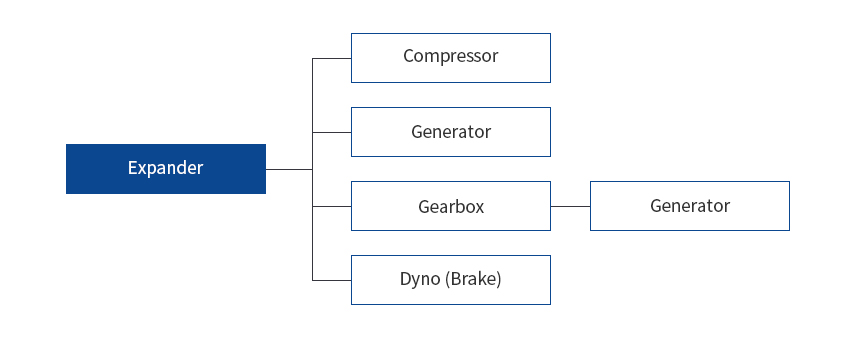Water treatment & Turbo expanders

(Turbo Expander)
Turboexpander Applications
- Hydrocarbon Gas / Oil Refinery Processing - LNG plant gas liquefication, , Fluid Catalyst Cracking (FCC), LPG recovery
- Cryogenic Air Separation - N2 gas production, cooling of air for stream condensation (Air Products, Praxair, Linde etc)
- Refrigeration - large scale gas refrigeration
- Energy Recovery - replaces expansion valves, electricity generation
- Geothermal Power Generation - power generation using ground water and refrigerants (134A or iso-butane)
Turboexpander Types
- Four main types connected to the expander shaft
* You can view it by scrolling left and right.
| Turboexpander Configurations ⑴⑵ |
EC**/EG/ED | EC/EG/ED | EC/EG/ED | EC/EG | EC/EG | EC/EG | |
|---|---|---|---|---|---|---|---|
Frame Sizes |
L1000 | L2000 | L3000 | L4000 | L5000 | L6000 | |
Inlet Flow |
ACMH |
600 | 1,500 | 4,000 | 7,500 | 10,000 | 16,000 |
ACFM |
350 | 880 | 2,350 | 4,400 | 5,900 | 9,400 | |
Inlet Pressure |
BARG |
206 | 206 | 206 | 206 | 206 | 206 |
PSIG |
3,000 | 3,000 | 3,000 | 3,000 | 3,000 | 3,000 | |
Temperature |
Celsius |
-195 to 260 ℃ | -195 to 260 ℃ | -195 to 260 ℃ | -195 to 260 ℃ | -195 to 260 ℃ | -195 to 260 ℃ |
Fahrenheit |
-320 to 500 ℉ | -320 to 500 ℉ | -320 to 500 ℉ | -320 to 500 ℉ | -320 to 500 ℉ | -320 to 500 ℉ | |
RPM (max.) |
105,000*** | 52,000 | 31,000 | 29,000 | 18,000 | 15,000 | |
Seal Types |
Labryinth Seal | Labryinth Seal/ Dry Gas |
Labryinth Seal/ Dry Gas |
Labryinth Seal/ Dry Gas |
Labryinth Seal/ Dry Gas |
Labryinth Seal/ Dry Gas |
|
Wheel Power |
kW |
800 kW | 1,500 kW | 3,000 kW | 6,000 kW | 10,000 kW | 14,000 kW |
hp |
1,070 hp | 2,000 hp | 4,000 hp | 8,000 hp | 13,400 hp | 18,700 hp | |
| Bearing Types ⑶ | Oil | Oil/AMB | Oil/AMB | Oil/AMB | Oil/AMB | Oil/AMB | |




